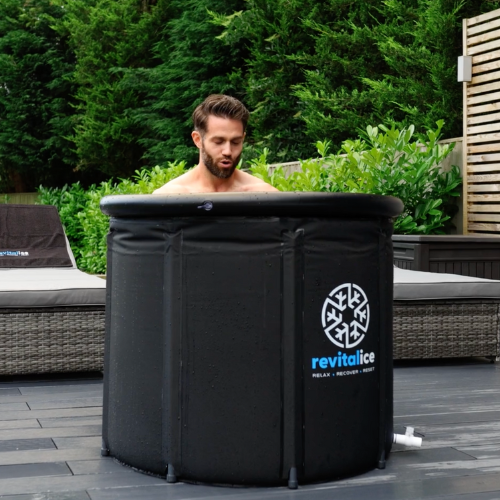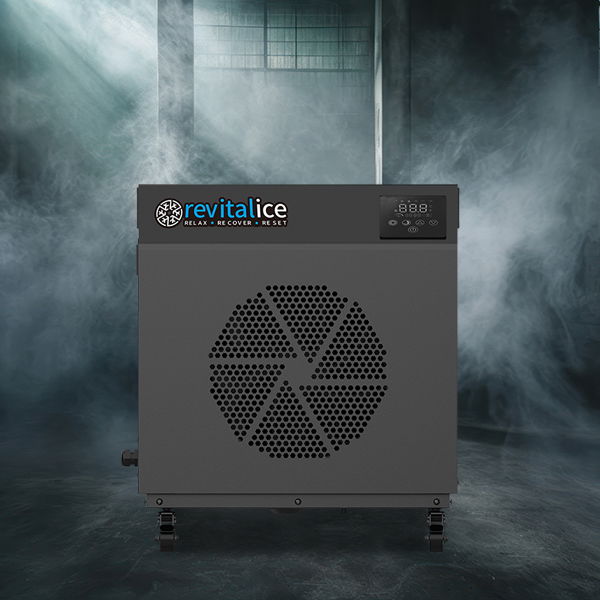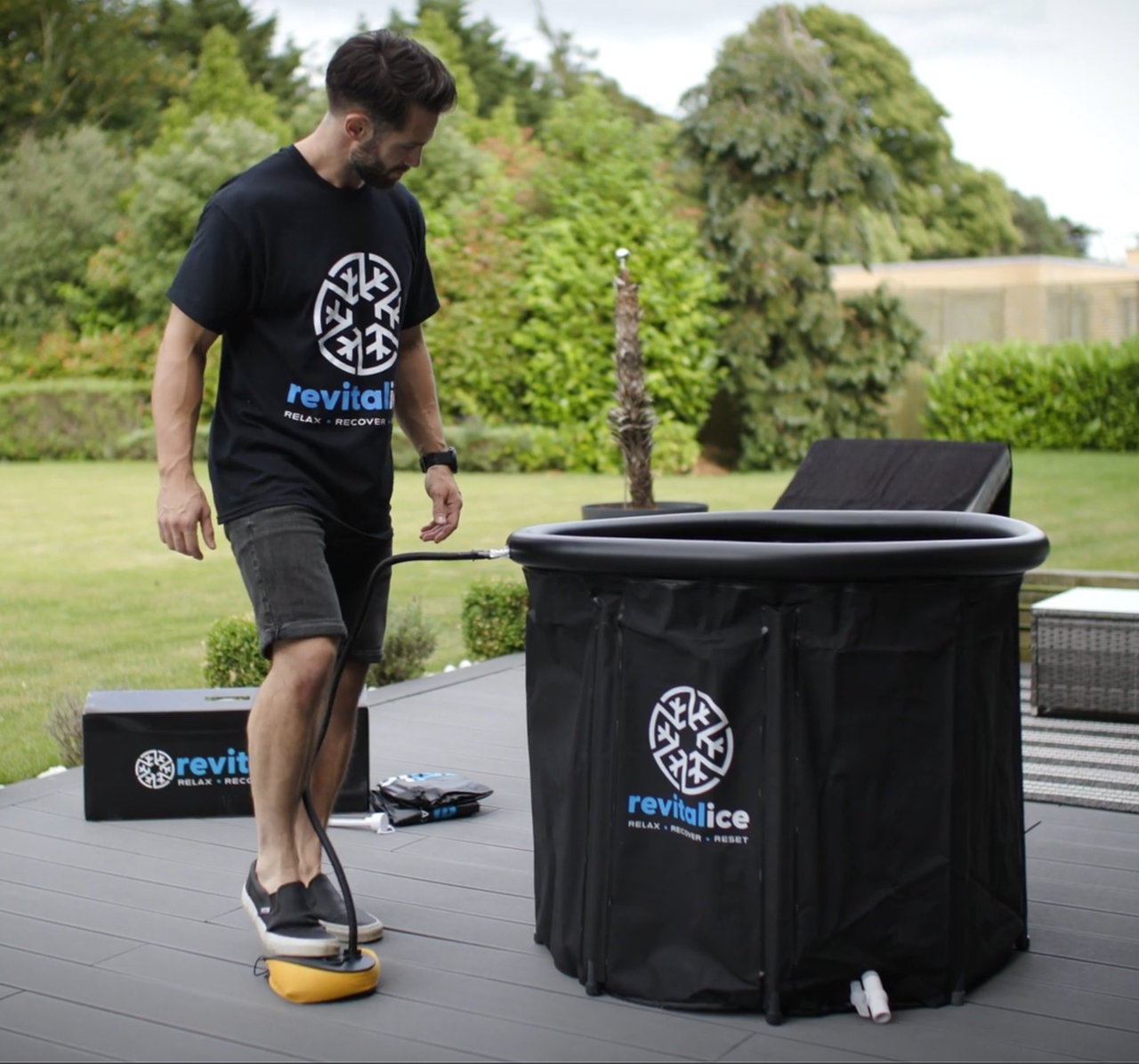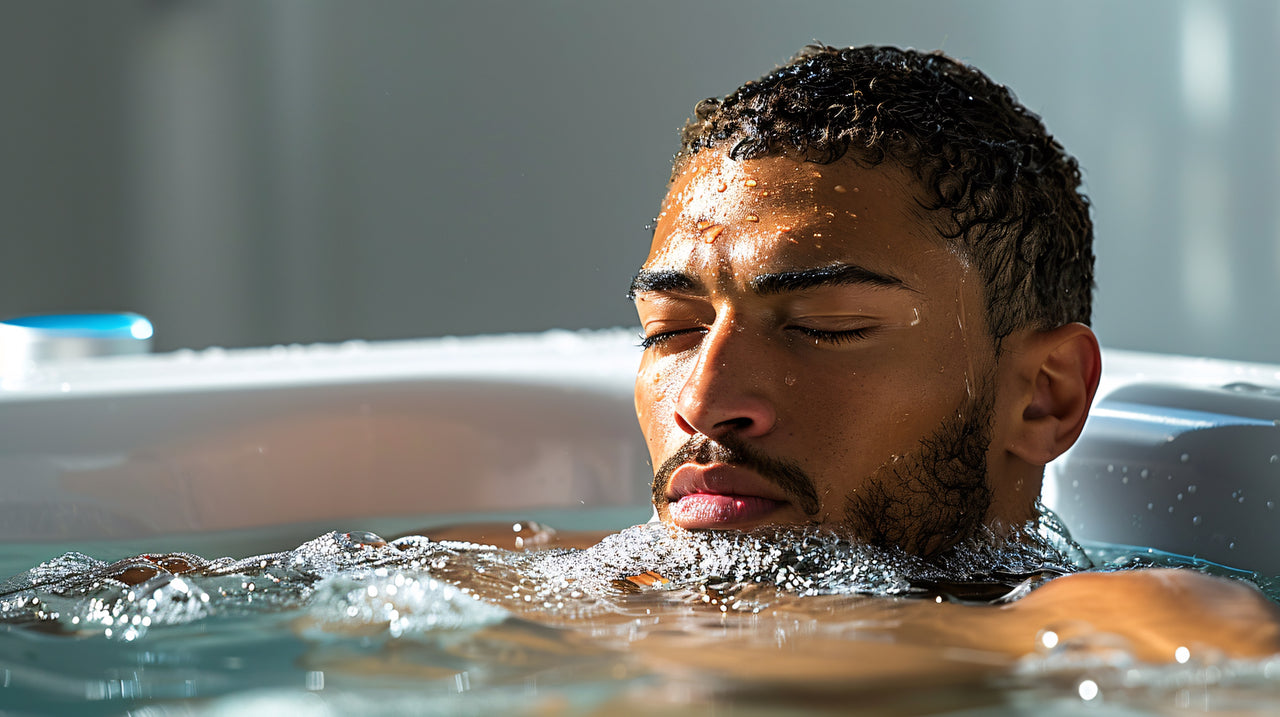
Awakening Strength Through Cold Water Therapy
Refresh your body and clear your mind through the rejuvenating power of cold therapy with a Revitalice Ice Bath Tub. Our ice baths and ice barrels are designed to be easy to set up and effective to use.
Enhance Recovery with Our Premium Ice Bath Tubs
At Revitalice, we believe that recovery is not just a step in your fitness journey—it’s a lifestyle.
Our luxury ice baths and cold plunge tubs are designed to elevate your recovery experience, combining cutting-edge design with the proven benefits of cold water immersion therapy.
Experience faster muscle recovery, improved circulation, and enhanced performance with our premium cold plunge solutions.
Discover why athletes, wellness enthusiasts, and high performers choose Revitalice for the ultimate recovery experience.
Feel the chill



Explore
Explore
Explore
Feel the change
Ice Baths
Chiller
Accessories
Designed for portability and convenience
Artic Smart Chiller designed to get colder
Everything you need to keep your bath healthy
Our Cold Water Therapy Solutions
The Science
Cold Therapy - An Empowering Lifestyle

Reduce inflammation & muscle soreness
Cold water immersion helps reduce inflammation and swelling, speeding up recovery after intense workouts.

Speeds up muscles recovery
Flush out lactic acid and metabolic waste while promoting faster muscle repair.

Improves circulation
Enhance blood flow to deliver nutrients and oxygen to tired muscles.

Boosts mental clarity & reduces stress
Trigger the release of endorphins and norepinephrine for improved mood and relaxation.

Enhances immune functions
Strengthen your immune system with regular cold exposure.

Support weight management & metabolism
Activate brown adipose tissue to boost metabolism and support weight management.

Science behind recovery
Backed by facts
Upto
20%
Less muscle soreness
Upto
30%
Improved mood
Upto
20%
Less recovery time
Upto
15%
Reduced heart rate
All stats are referenced from Journal of Applied Physiology 2017, British Journal of Sports Medicine 2016, Frontiers in Physiology, Applied Physiology 2015.
Why Revitalice Ice Baths

High quality materials
Made with 6 layers offering longevity

For athletes and beginners
Crafted for improving your recovery

Free UK delivery
We offer a FREE next day UK delivery

Free extra's
£100 worth of free extras with your Ice Bath

UK support
Dedicated team based in the UK

Peace of mind
All our Ice Baths come with a warranty
Questions you asked
answered by our experts
Ice baths offer a wide range of physical and mental benefits, making them popular with athletes, fitness enthusiasts, and anyone looking to improve recovery and wellbeing.
Key benefits include:
- Faster muscle recovery – reduces inflammation and soreness after intense training.
- Improved circulation – the cold constricts blood vessels, then promotes fresh blood flow as you warm up.
- Reduced swelling and injury support – helpful for sprains, strains, and overworked joints.
- Boosted immunity – regular cold exposure may strengthen the immune system.
- Stress relief – lowers cortisol and encourages relaxation.
- Enhanced mental resilience – builds discipline, focus, and tolerance to controlled discomfort.
- Better sleep quality – many users find ice baths help them unwind and sleep more deeply.
Using an ice bath consistently can support recovery, performance, and overall wellbeing.
An ice bath is a form of cold water immersion therapy, where the body is submerged in cold water, typically between 5–15°C. The sudden cold triggers vasoconstriction, which reduces blood flow to muscles, helping to decrease inflammation, swelling, and soreness.
When you exit the ice bath, blood vessels dilate again, flushing fresh oxygenated blood into your muscles to aid recovery. Beyond physical benefits, ice baths can also boost mental resilience, improve circulation, and support overall wellbeing.
Key points about how ice baths work:
- Reduces inflammation and muscle soreness after exercise.
- Boosts circulation by alternating constriction and dilation of blood vessels.
- Supports recovery from intense workouts or minor injuries.
- Enhances mental toughness through controlled cold exposure.
Ice baths are widely used by athletes and fitness enthusiasts as part of a recovery and performance routine.
Proper preparation ensures your ice bath is safe, effective, and comfortable. Following a few simple steps helps you get the most benefit from cold water immersion:
Steps to prepare:
- Hydrate beforehand – drink water to prevent dehydration.
- Set the water temperature – typically between 5–15°C, depending on your experience and tolerance.
- Wear the right clothing – swimwear or light athletic clothing is ideal for comfort.
- Mentally prepare – practice deep, controlled breathing and visualise staying calm in the cold.
- Use a timer – start with 2–3 minutes if you are a beginner and gradually increase minutes as you build tolerance.
- Consider a light warm-up – gentle stretching or movement before entering can ease the transition.
By preparing correctly, you maximise recovery, reduce discomfort, and make your ice bath sessions both safe and effective.
The ideal duration of an ice bath depends on your experience, tolerance, and recovery goals.
Guidelines:
- Beginners: Start with 2–3 minutes to allow your body to adapt to the cold.
- Intermediate users: 5–8 minutes is effective for muscle recovery and inflammation reduction.
- Advanced users/athletes: Up to 10 minutes can be tolerated, but only if your body is well-adapted to cold exposure.
Tips for safe use:
- Always listen to your body and exit if you feel extreme discomfort, numbness, or dizziness.
- Use a timer to avoid staying in too long.
- Gradually increase duration over time rather than forcing long sessions immediately.
Staying within recommended times maximises recovery benefits while keeping the session safe and comfortable.
Yes, ice baths can be used safely indoors, provided a few precautions are taken to protect your home and ensure safety.
Tips for indoor use:
- Choose a waterproof surface – place the ice bath on tiles, vinyl, or a waterproof mat to prevent water damage.
- Use a drain or protective tray – ensure any overflow or spills are controlled.
- Ventilate the room – cold water can create humidity, so a well-ventilated space is recommended.
- Consider portability – portable ice baths are ideal for indoor use as they are easy to set up and store.
- Have a towel or mat nearby – for safe entry and exit.
Indoor ice baths offer the convenience of recovery at home, making it easy to incorporate regular cold-water therapy into your routine.
Proper post-ice bath care helps maximise recovery and keeps you safe and comfortable.
Steps to follow after an ice bath:
- Warm up gradually – dry off and put on warm clothing rather than jumping straight into hot water.
- Move gently – light stretching or walking encourages blood flow and helps muscles recover.
- Hydrate – drink water to replenish fluids lost during the session.
- Refuel if needed – a small snack with protein can support muscle repair.
- Rest and relax – allow your body and mind to recover fully before intense activity.
Following these steps ensures you get the full benefits of the ice bath while minimising discomfort and aiding recovery.
Ice baths are generally safe for most healthy adults, but they may not be suitable for everyone. Certain individuals should take precautions or consult a healthcare professional before using cold-water immersion.
Considerations:
- Heart conditions or high blood pressure – sudden cold exposure can strain the cardiovascular system.
- Pregnancy – pregnant women should seek medical advice before using an ice bath.
- Children and young teens – only recommended with supervision and mild temperatures.
- Medical conditions – anyone with chronic illnesses, circulation issues, or sensitivity to cold should consult a doctor.
For most healthy adults, ice baths are a safe and effective tool for recovery and mental resilience when used correctly and within recommended durations.
Athletes often incorporate ice baths to speed up recovery, reduce muscle soreness, and maintain peak performance.
Typical uses:
- Post-training recovery – immersing in cold water after intense sessions helps reduce inflammation and muscle fatigue.
- Between competitions – short ice baths can aid faster recovery during multi-day tournaments or events.
- Contrast therapy – alternating between hot and cold water can improve circulation and further support recovery.
- Mental conditioning – controlled exposure to cold helps build focus, discipline, and resilience.
By integrating ice baths strategically, athletes can enhance performance, reduce injury risk, and recover more efficiently between training sessions.
To keep your ice bath fresh and hygienic, it’s important to maintain both the water and the tub itself. Here are some best practices:
- Change the water regularly – every 2–5 sessions depending on use.
- Rinse after use – a quick rinse removes sweat, dirt, or debris.
- Use sanitising tablets or filters – these extend water freshness and reduce bacteria build-up.
- Keep it covered – a lid or protective cover prevents leaves, insects, or dust getting in.
- Deep clean weekly – scrub the interior with a mild solution, then rinse thoroughly.
At Revitalice, we also offer a range of specialised cleaning products designed to keep your ice bath hygienic and easy to maintain, ensuring every session feels safe and refreshing.
When choosing an ice bath, certain features can make your experience safer, more convenient, and more effective.
Key features to consider:
- Durability and build quality – strong, high-quality materials ensure your ice bath lasts for years.
- Insulation – good insulation helps maintain cold water for longer periods.
- Portability – lightweight or foldable models are easier to store and move.
- Size and capacity – ensure the bath is large enough to comfortably fit your body.
- Drainage system – easy drainage makes cleaning and refilling simple.
- Temperature control – some models allow you to adjust or maintain water temperature more effectively.
- Ease of cleaning – smooth interiors, removable liners, or compatibility with sanitising products make maintenance easier.
Choosing the right features ensures a comfortable, safe, and effective cold water recovery experience tailored to your needs.
Yes, ice baths can be an effective tool for managing stress by influencing both the body and mind.
How they help:
- Reduces cortisol levels – cold exposure helps lower the stress hormone, promoting relaxation.
- Endorphin release – immersion triggers the release of feel-good hormones, improving mood.
Mental resilience – regularly facing the controlled discomfort of cold water strengthens focus and emotional discipline.
Mindfulness and breathing – staying calm during an ice bath encourages deep, controlled breathing and mental clarity.
Incorporating ice baths into your routine can help reduce daily stress, improve emotional resilience, and support overall mental wellbeing.
Cold water and warm water therapy are both forms of hydrotherapy, but they work in opposite ways and provide different benefits:
Cold Water Therapy (Ice Baths / Cold Plunge):
- Reduces inflammation and soreness – constricts blood vessels to limit swelling.
- Speeds up muscle recovery – flushes out metabolic waste once you warm up.
- Boosts mental resilience – controlled cold exposure builds focus and discipline.
- Can improve circulation – alternating cold and warm increases blood flow.
Warm Water Therapy (Hot Tubs / Saunas / Baths):
- Relaxes muscles – dilates blood vessels to increase blood flow and ease tension.
- Reduces stiffness – helps with joint mobility and comfort.
- Promotes relaxation and stress relief – calms the nervous system and improves sleep.
Supports detoxification – warmth encourages sweating, which can aid in flushing toxins.
Key Difference: Cold therapy is primarily for recovery and reducing inflammation, while warm therapy is mainly for relaxation, easing stiffness, and comfort. Many people combine both in contrast therapy for maximum recovery and circulation benefits.
Cold water immersion (ice baths) works by triggering physiological responses in the body that support recovery, performance, and wellbeing.
How it works:
- Vasoconstriction – exposure to cold causes blood vessels to constrict, reducing inflammation, swelling, and muscle soreness.
- Vasodilation after warming – when you exit the ice bath, blood vessels expand, increasing blood flow and delivering oxygen and nutrients to muscles for repair.
- Reduced metabolic waste – flushing out lactic acid and other byproducts helps muscles recover faster.
- Activation of the nervous system – the cold stimulates the release of endorphins and adrenaline, which can improve mood and mental resilience.
- Immune system support – regular exposure may increase white blood cell activity and enhance immune response.
Cold water immersion combines these physiological effects to support faster recovery, reduced fatigue, improved circulation, and increased mental toughness.
Yes, ice baths can support the immune system when used regularly as part of a healthy routine.
How they help:
- Increased white blood cell activity – regular cold exposure may stimulate the body’s immune response.
- Enhanced circulation – improved blood flow helps deliver immune cells throughout the body.
- Stress reduction – lowering cortisol through cold therapy supports overall immune health.
- Activation of the nervous system – controlled cold exposure triggers beneficial physiological responses that can strengthen resilience to illness.
While ice baths are not a replacement for proper nutrition, sleep, and medical care, they can be a valuable tool to support overall immune function and recovery.
Yes, ice baths can support both mental health and resilience through controlled exposure to cold, which challenges the body and mind in a beneficial way.
How they help:
- Stress reduction – cold exposure lowers cortisol levels, helping to manage stress.
- Endorphin release – the body produces feel-good hormones during cold immersion, improving mood.
- Mental toughness – regularly enduring the discomfort of an ice bath builds discipline, focus, and emotional resilience.
- Mindfulness and presence – staying calm during cold immersion encourages controlled breathing and mental clarity.
Incorporating ice baths into a routine can enhance mental wellbeing, improve stress management, and strengthen resilience to daily challenges.
Ice baths can have a supportive effect on metabolism, but they should not be relied on as a primary method for weight loss.
How they can help:
- Activates brown fat – exposure to cold stimulates brown adipose tissue, which burns calories to generate heat.
- Boosts calorie expenditure – the body uses energy to maintain core temperature during cold immersion.
- Supports overall metabolism – regular cold exposure can complement a healthy diet and exercise routine.
While ice baths can slightly increase calorie burn, they are most effective when combined with proper nutrition and regular physical activity for weight management.
Portable ice baths offer convenience, flexibility, and practicality for both home and professional use.
Key advantages:
- Easy setup and storage – lightweight and foldable designs make them simple to set up and store when not in use.
- Flexible placement – can be used indoors or outdoors without permanent installation.
- Temperature control – many portable models allow you to maintain cold water consistently.
- Cost-effective – typically more affordable than built-in or permanent cold plunge tubs.
- Accessibility – ideal for athletes, fitness enthusiasts, or anyone wanting convenient recovery at home or while traveling.
Portable ice baths combine the benefits of cold water immersion with ease of use, making it simple to incorporate regular recovery sessions into your routine.
The frequency of changing the water in an ice bath depends on usage, hygiene, and any treatment or filtration being used.
Guidelines:
- Light use (1–2 sessions per week): water can often last up to a week with proper maintenance.
- Frequent use (daily or multiple times per day): change water every 2–5 sessions to maintain hygiene.
- Use of sanitising tablets or filters: treated water may last longer, but regular checks for clarity and cleanliness are still important.
- Hygiene and safety: always change the water if it appears cloudy, has an odor, or contains debris.
Regular water changes ensure your ice bath stays clean, hygienic, and safe for every session.
Ice baths and cryotherapy chambers are both cold therapies used for recovery, but they work differently and offer distinct benefits.
Ice Baths:
- Involves full or partial immersion in cold water, usually 5–15°C.
- Reduces inflammation and muscle soreness through vasoconstriction and improved circulation.
- Accessible at home with portable or permanent tubs.
- Provides mental resilience benefits through controlled cold exposure.
Cryotherapy Chambers:
- Uses extremely cold air (often below −100°C) to expose the body to short bursts of cold.
- Typically sessions last 2–3 minutes.
- Mainly available at specialist clinics or gyms.
- Targets recovery and inflammation without full immersion.
Key Difference: Ice baths use water immersion, giving a full-body cold exposure and longer session times, whereas cryotherapy uses cold air, offering very brief, intense cold sessions. Many athletes use both depending on their recovery needs and convenience.
Yes, ice baths can have positive effects on both skin and circulation when used regularly as part of a recovery routine.
How they help:
- Improved circulation – cold water causes blood vessels to constrict, then dilate after leaving the bath, which boosts blood flow and oxygen delivery.
- Healthier skin appearance – the cold can tighten pores and reduce puffiness, giving the skin a firmer, refreshed look.
- Detoxification support – improved circulation helps remove metabolic waste from the body more efficiently.
- Enhanced recovery – better blood flow helps muscles and tissues repair faster, which indirectly benefits skin health.
Regular ice baths support overall circulation, refresh the skin, and complement a holistic approach to recovery and wellbeing.







